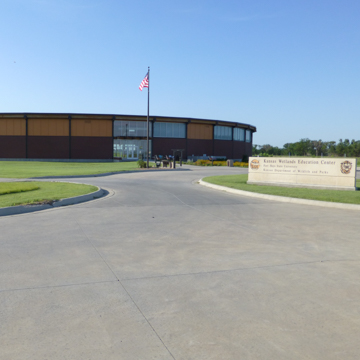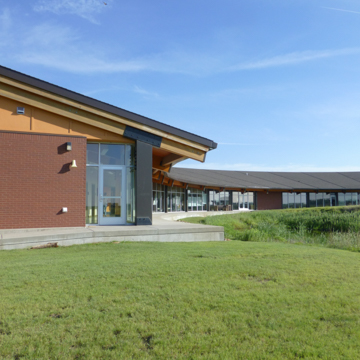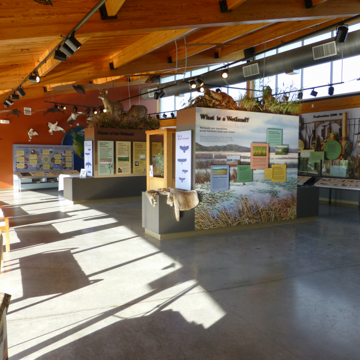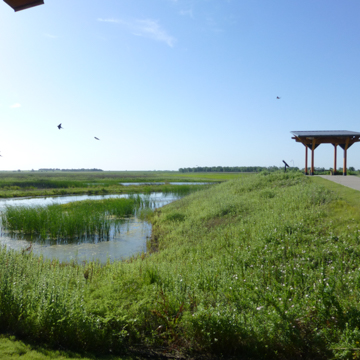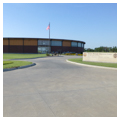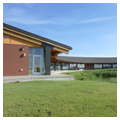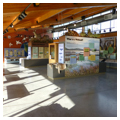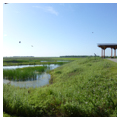The Kansas Wetlands Education Center sits on the southern edge of the Cheyenne Bottoms Wetland, the largest wetland and most important habitat for migrating shorebirds in the country’s interior. The building acts as a gateway to a truly remarkable environment. The Kansas Wetlands contain 41,000 acres that are home to 340 species of birds at certain times of the year, including a number of endangered species such as the whooping crane, bald eagle, peregrine falcon, least turn, and piping plover. These wetlands are the permanent home for sixty species, while for others it an important stop on annual migrations or a place to spend the winters. The wetlands are also home to a variety of mammals and reptiles. The Education Center is dedicated to the interpretation of this environment.
Designed by Bowman Bowman Novick of Manhattan, Kansas, the Education Center is a simple, crescent-shaped structure inspired by the typical layout of encampments of the Pawnee and Cheyenne Indians who once inhabited the region. One approaches the building from the outside of the crescent on a typical rural highway. The building is mostly opaque on the entry side, but as one enters the structure, the magical wetlands landscape is revealed. The inner part of the crescent is largely glazed, and focuses on a raised viewing platform that looks out across the marshland. The platform was planned as a much taller tower, but budget constraints allowed only a more modest vantage point.
The Education Center contains displays describing the history and management challenges of the area, as well as the many species of plants and variety of creatures that are supported by the wetland environment. It also houses a theater, classrooms, gift shop, staff offices, and support spaces. The spaces rest easily within a potentially challenging curvilinear volume. Most of the rooms benefit from views out into the marshes, and enjoy natural light from both high windows on the entry side and the panoramic windows on the wetlands side. A wood ceiling and glue-laminated wood framing structure give the spaces a natural feel. Sustainable strategies, including the use of locally manufactured brick and careful storm water management, bring the building into alignment with its natural surroundings.
The geological conditions that created the great depression containing the wetlands remains something of a mystery. Such places are becoming ever scarcer, as conversion to agricultural land and the depletion of groundwater have claimed over half of Kansas wetlands. Cheyenne Bottoms was under threat of drainage before the Kansas Department of Wildlife and Parks and the Nature Conservancy began acquiring land there in the 1940s. The state developed a water management system that included the construction of a system of dikes, the digging of canals to bring water to the area, and the creation of five holding ponds. These ensure that the area can serve as a viable habitat for the variety of birds that have come to count on the hospitality that the wetlands provide, even during drought conditions.
References
Kansas Sampler Foundation. Eight Wonders of Kansas. Newton, KS: Mennonite Press, 2011.

